Comparison between Density and Velocity Fields in Burst Modulation of a Dielectric-Barrier-Discharge Plasma Actuator
Abstract
:1. Introduction
2. Experimental Methods and Conditions
2.1. Experimental Settings and Details of DBDPA
2.2. Experimental Conditions for Driving the DBDPA
3. Experimental Results
3.1. Classification of Flow-Field Patterns and Comparison of Density and Vorticity Fields
3.2. Comparison of Density and Vorticity Fields
4. Conclusions
Author Contributions
Funding
Data Availability Statement
Conflicts of Interest
References
- Benard, N.; Moreau, E. Electrical and mechanical characteristics of surface AC dielectric barrier discharge plasma actuators applied to airflow control. Exp. Fluids 2014, 55, 1–43. [Google Scholar] [CrossRef] [Green Version]
- Moreau, E. Airflow control by non-thermal plasma actuators. J. Phys. D: Appl. Phys. 2007, 40, 605. [Google Scholar] [CrossRef]
- Thomas, F.O.; Corke, T.C.; Iqbal, M.; Kozlov, A.; Schatzman, D. Optimization of Dielectric Barrier Discharge Plasma Actuators for Active Aerodynamic Flow Control. AIAA J. 2009, 47, 2169–2178. [Google Scholar] [CrossRef] [Green Version]
- Lilley, A.J.; Roy, S.; Michels, L.; Roy, S. Performance Recovery of Plasma Actuators in Wet Conditions. J. Phys. D Appl. Phys. 2022, 55, 155201. [Google Scholar] [CrossRef]
- Tanaka, T.; Matsuda, H.; Takahashi, T.; Chiba, T.; Watanabe, N.; Sato, H.; Takeyama, M. Experimental Study on the Snowfall Flow Control of Backward-Facing Steps Using a High-Durability Designed Plasma Electrode. Actuators 2022, 11, 313. [Google Scholar] [CrossRef]
- Tanaka, M.; Kubo, N.; Kawabata, H. Plasma actuation for leading edge separation control on 300-kW rotor blades with chord length around 1 m at a Reynolds number around 1.6 × 106. J. Phys.: Conf. Ser. 2020, 1618, 052013. [Google Scholar] [CrossRef]
- Enloe, C.L.; McLaughlin, T.E.; Dyken, R.V.; Kachner, K.D.; Jumper, E.J.; Corke, T.C.; Post, M.; Haddad, O. Mechanisms and Responses of a Dielectric Barrier Plasma Actuator: Geometric Effects. AIAA J. 2004, 42, 595–604. [Google Scholar] [CrossRef]
- Nakano, A.; Nishida, H. The effect of the voltage waveform on performance of dielectric barrier discharge plasma actuator. J. Appl. Phys. 2019, 126, 173303. [Google Scholar] [CrossRef]
- Durscher, R.J.; Roy, S. Three-dimensional flow measurements induced from serpentine plasma actuators in quiescent air. J. Phys. D: Appl. Phys. 2012, 45, 035202. [Google Scholar] [CrossRef] [Green Version]
- Riherd, R.; Roy, S. Serpentine geometry plasma actuators for flow control. J. Appl. Phys. 2013, 114, 083303. [Google Scholar] [CrossRef]
- Gupta, A.D.; Roy, S. Modification of energetic modes for transitional flow control. AIP Adv. 2022, 12, 035149. [Google Scholar] [CrossRef]
- Wang, J.J.; Choi, K.S.; Feng, L.H.; Jukes, T.N.; Whalley, R.D. Recent developments in DBD plasma flow control. Prog. Aerosp. Sci. 2013, 62, 52–78. [Google Scholar] [CrossRef]
- Portugal, S.; Choudhury, B.; Lilley, A.; Charters, C.; Porrello, C.; Lin, J.; Roy, S. A fan-shaped plasma reactor for mixing en-hancement in a closed chamber. J. Phys. D: Appl. Phys. 2020, 53, 22LT01. [Google Scholar] [CrossRef]
- Sato, M.; Nonomura, T.; Okada, K.; Asada, K.; Aono, H.; Yakeno, A.; Abe, Y.; Fuji, K. Mechanisms for laminar separated-flow control using dielectric-barrier-discharge plasma actuator at low Reynolds number. Phys. Fluids 2015, 27, 117101. [Google Scholar] [CrossRef]
- Corke, T.C.; He, C.; Patel, M.P. Plasma flaps and slats: An application of weakly-ionized plasma actuators. J. Aircr. 2009, 46, 864–873. [Google Scholar] [CrossRef]
- Sidorenko, A.; Zanin, B.; Postnikov, B.; Budovsky, A.; Starikovskii, A.; Roupassov, D.; Zavialov, I.; Malmuth, N.; Smereczniak, P.; Silkey, J. Pulsed Discharge Actuators for Rectangular Wings Separation Control. In Proceedings of the AIAA Aerospace Sciences Meeting and Exhibit, Reno, NV, USA, 8–11 January 2007. [Google Scholar] [CrossRef]
- Fujii, K. Three Flow Features behind the Flow Control Authority of DBD Plasma Actuator: Result of High-Fidelity Simula-tions and the Related Experiments. Appl. Sci. 2018, 8, 546. [Google Scholar] [CrossRef] [Green Version]
- Greenblatt, D.; Schneider, T.; Schule, C.Y. Mechanism of flow separation control using plasma actuation, Phys. Fluids 2012, 24, 077102. [Google Scholar] [CrossRef]
- Sekimoto, S.; Tanaka, N.; Nonomura, T.; Nishida, H.; Fujii, K. Experimental Study of Burst Ratio Effect for Dielectric-Barrier-Discharge Plasma Actuator for Separation Control. Proceedings of 55th AIAA Aerospace Sciences Meeting, Grapevine, TX, USA, 9–13 January 2017. [Google Scholar] [CrossRef]
- Sekimoto, S.; Nonomura, T.; Fujii, K. Burst-Mode Frequency Effects of Dielectric Barrier Discharge Plasma Actuator for Separation Control. AIAA J. 2017, 55, 1385 1392. [Google Scholar] [CrossRef]
- Suzuki, K.; Komuro, A.; Nonomura, T.; Asai, K.; Ando, A. Effect of burst ratio on flow separation control using a dielectric barrier discharge plasma actuator at Reynolds number 2.6 × 105. J. Phys. D: Appl. Phys. 2021, 54, 315204. [Google Scholar] [CrossRef]
- Vukasinovic, B.; Glezer, A. Transitory Fluidic Control of Turbulent Shear Flows. In Proceedings of the 36th AIAA Fluid Dynamics Conference and Exhibit, Washington, DC, USA, 5–8 June 2006. [Google Scholar] [CrossRef] [Green Version]
- Chen, D.; Asada, K.; Sekimoto, S. A high-fidelity body-force modeling approach for plasma-based flow control simulations. Phys. Fluids 2021, 33, 037115. [Google Scholar] [CrossRef]
- Whalley, R.D.; Choi, K.S. The starting vortex in quiescent air induced by dielectric-barrier-discharge plasma. J. Fluid Mech. 2012, 703, 192–203. [Google Scholar] [CrossRef] [Green Version]
- Mishra, B.K.; Panigrahi, P.K. Formation and characterization of the vortices generated by a DBD plasma actuator in burst mode. Phys. Fluids 2017, 29, 024104. [Google Scholar] [CrossRef]
- Mishra, B.K.; Panigrahi, P.K. Flow field induced by a dielectric barrier discharge plasma actuator analyzed with bi–orthogonal decomposition. Phys. Fluids 2020, 32, 087112. [Google Scholar] [CrossRef]
- Xue, M.; Gao, C.; Xi, H.D.; Liu, F. Vortices Induced by a Dielectric Barrier Discharge Plasma Actuator Under Burst-Mode Actuation. AIAA J. 2020, 58, 2428–2441. [Google Scholar] [CrossRef]
- Aono, H.; Sekimoto, S.; Sato, M.; Yakeno, A.; Nonomura, T.; Fujii, K. Computational and experimental analysis of flow structures induced by a plasma actuator with burst modulations in quiescent air. Mech. Eng. J. 2015, 2, 1–16. [Google Scholar] [CrossRef] [Green Version]
- Hasegawa, D.; Nakano, K.; Nakano, A.; Nishida, H. Numerical Study on Flow Field Produced by Burst Mode Actuation of DBD Plasma Actuator. In Proceedings of the Ninth JSME-KSME Thermal and Fluids Engineering Conference, Okinawa, Japan, 27–30 October 2017. TFEC9-1109. [Google Scholar]
- Emori, K.; Kaneko, Y.; Nishida, H. Influence of Main Flow on Vortex Structure Generated by Burst Mode Actuation of DBD Plasma Actuator. In Proceedings of the AIAA SCITECH 2022 Forum, San Diego, CA, USA, 3–7 January 2022. [Google Scholar] [CrossRef]
- Mishra, B.K.; Gupta, A.; Panigrahi, P.K. Near-wall characteristics of wall-normal jets generated by an annular dielec-tric-barrier-discharge plasma actuator. Phys. Rev. Fluids 2022, 7, 033702. [Google Scholar] [CrossRef]
- Emori, K.; Kaneko, Y.; Nishida, H. Classification of Flow-Field Patterns in Burst-Mode Actuation of a Dielec-tric-Barrier-Discharge Plasma Actuator. Phys. Fluids 2022, 34, 023601. [Google Scholar] [CrossRef]
- Raffel, M. Background-oriented schlieren (BOS) techniques. Exp. Fluids 2015, 56, 1–17. [Google Scholar] [CrossRef] [Green Version]
- Settles, G.S.; Hargather, M.J. A review of recent developments in Schlieren and shadowgraph techniques. Meas. Sci. Technol. 2017, 28, 042001. [Google Scholar] [CrossRef]
- Hayasaka, K.; Tagawa, Y.; Liu, T.; Kameda, M. Optical-flow-based background-oriented Schlieren technique for measuring a laser-induced underwater shock wave. Exp. Fluids 2016, 57, 179. [Google Scholar] [CrossRef] [Green Version]
- Yamamoto, S.; Tagawa, Y.; Kameda, M. Application of background-oriented schlieren (BOS) technique to a laser-induced underwater shock wave. Exp. Fluids 2015, 56, 93. [Google Scholar] [CrossRef] [Green Version]
- Hayasaka, K.; Tagawa, Y. Mobile visualization of density fields using smartphone background-oriented schlieren. Exp. Fluids 2019, 60, 171. [Google Scholar] [CrossRef] [Green Version]
- Komuro, A.; Tahashima, K.; Suzuki, K.; Kanno, S.; Nonomura, T.; Kaneko, T.; Ando, A.; Asai, K. Influence of discharge energy on the lift and drag forces induced by a nanosecond-pulse-driven plasma actuator. Plasma Sources Sci. Technol. 2019, 28, 065006. [Google Scholar] [CrossRef]
- Komuro, A.; Ogura, N.; Ito, M.; Nonomura, T.; Asai, K.; Ando, A. Visualization of density variations produced by alternat-ing-current dielectric-barrier-discharge plasma actuators using the background-oriented schlieren method. Plasma Sources Sci. Technol. 2019, 28, 055002. [Google Scholar] [CrossRef]
- Kaneko, Y.; Nishida, H.; Tagawa, Y. Background-oriented schlieren measurement of near-surface density field in surface dielectric-barrier-discharge. Meas. Sci. Technol. 2021, 32, 125402. [Google Scholar] [CrossRef]
- Kaneko, Y.; Nishida, H.; Tagawa, Y. Visualization of the Electrohydrodynamic and Thermal Effects of AC-DBD Plasma Ac-tuators of Plate- and Wire-Exposed Electrodes. Actuators 2022, 11, 38. [Google Scholar] [CrossRef]
- Pons, J.; Moreau, E.; Touchard, G. Asymmetric surface dielectric barrier discharge in air at atmosphere pressure: Electrical properties and induced airflow characteristics. J. Phys. D Appl. Phys. 2005, 38, 3635–3642. [Google Scholar] [CrossRef]
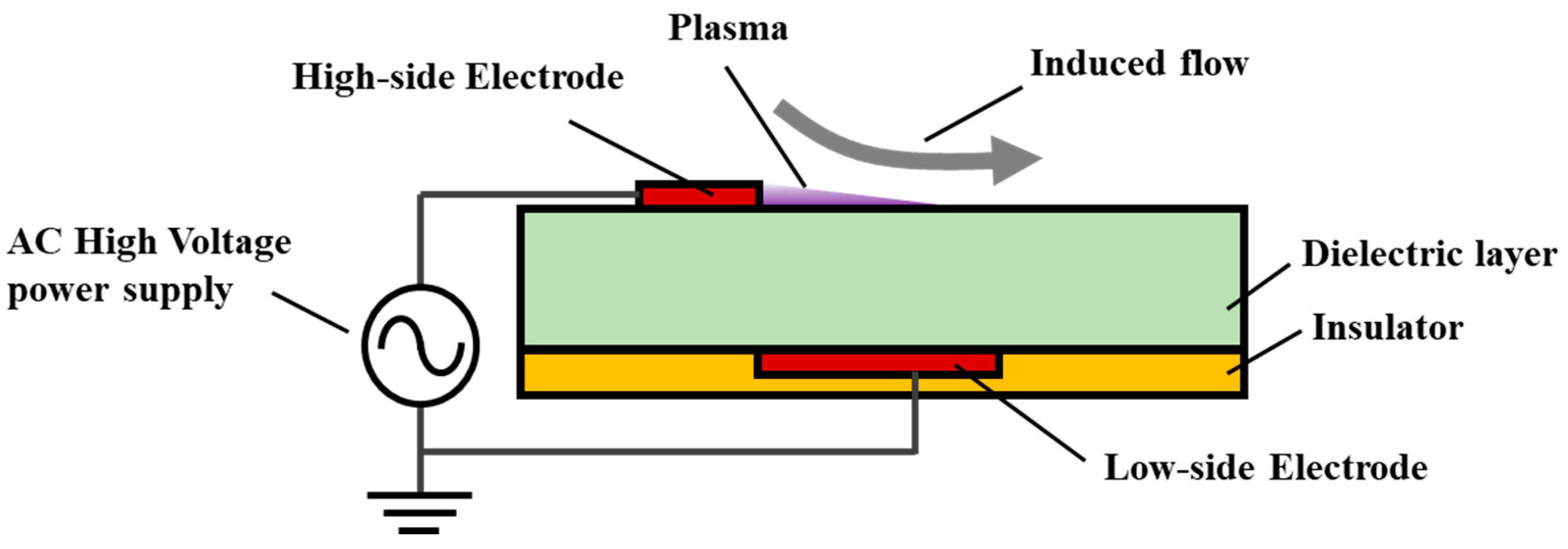

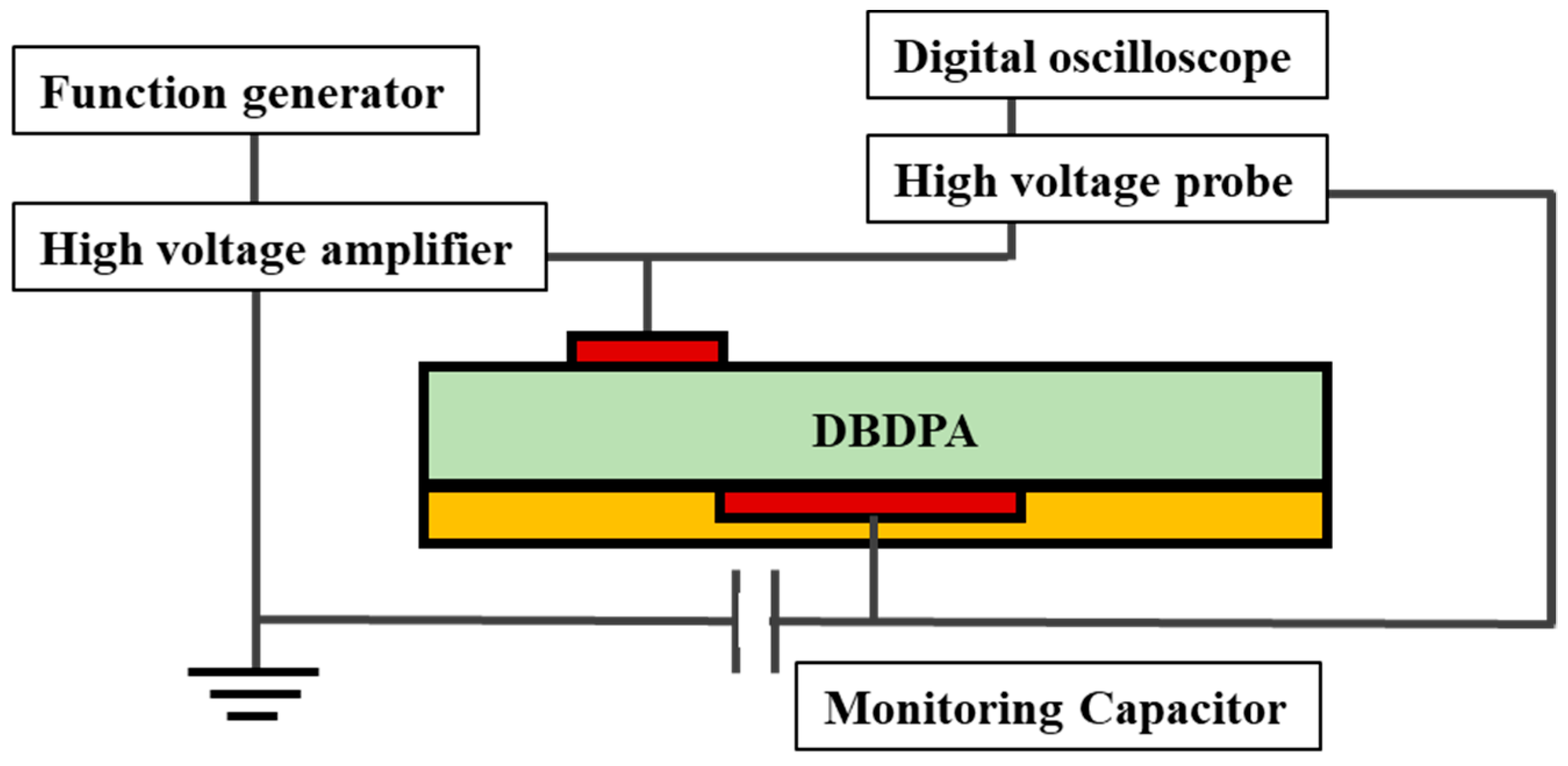
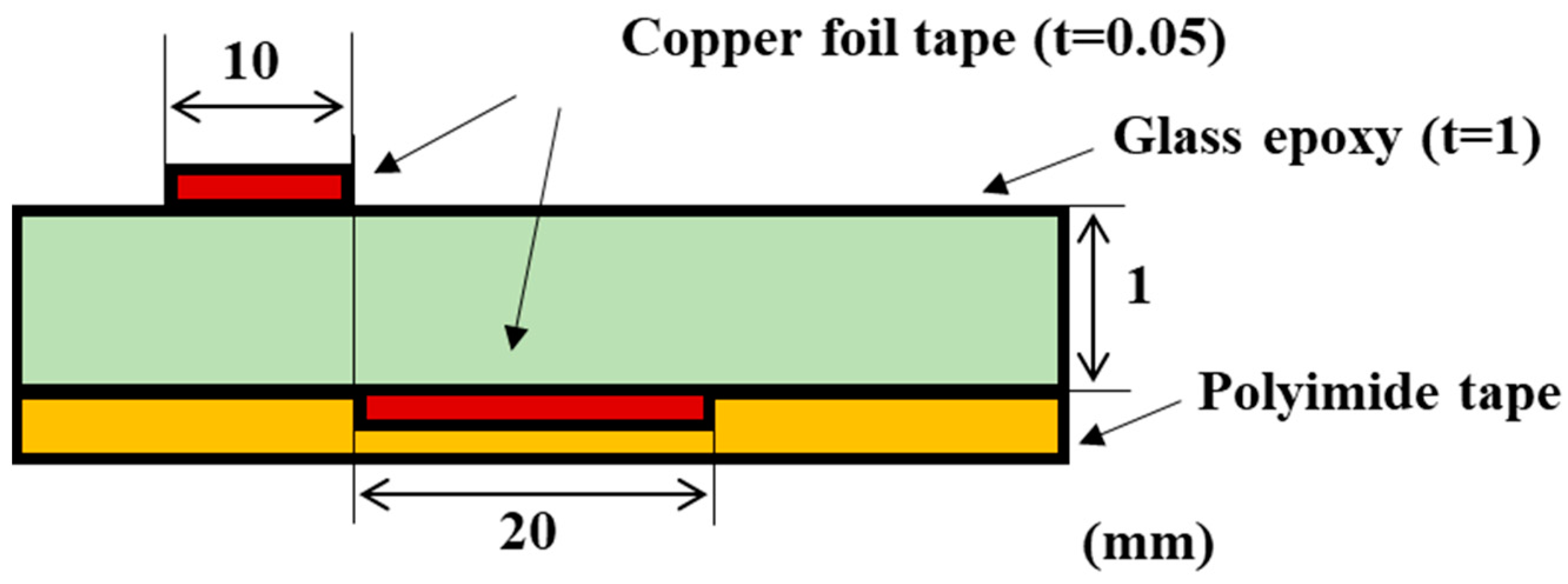
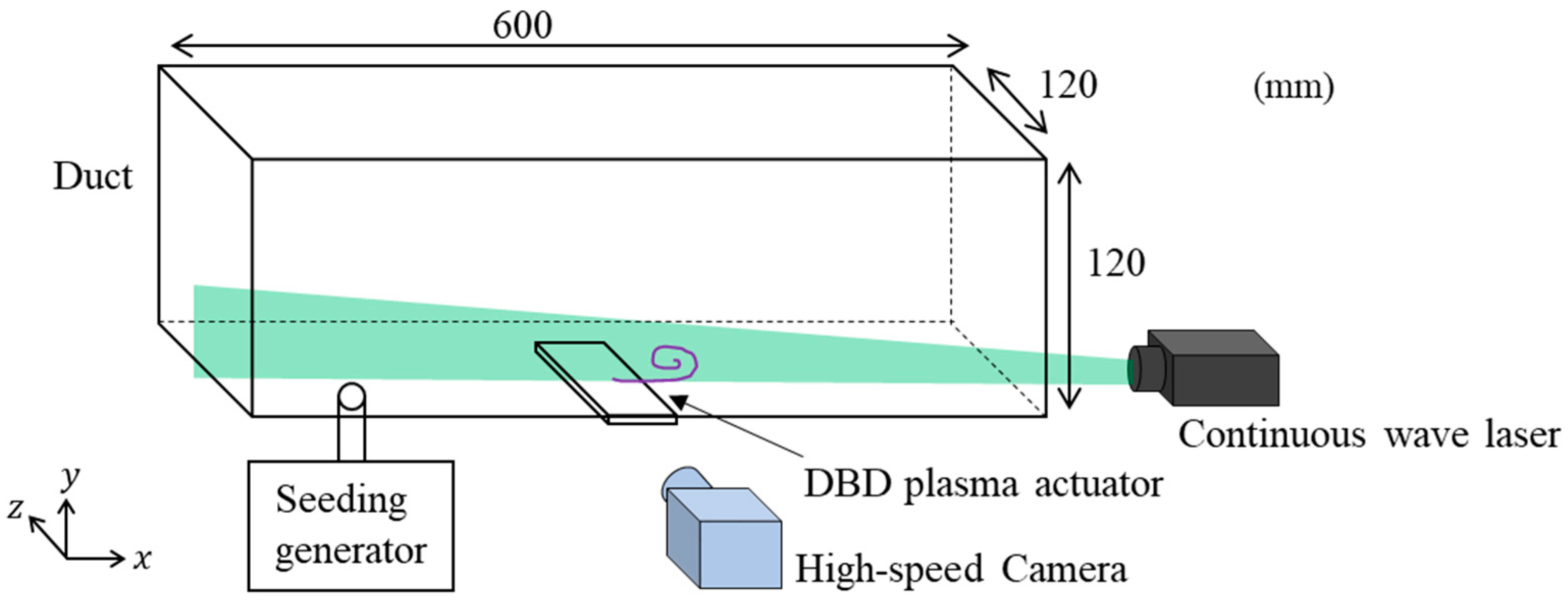
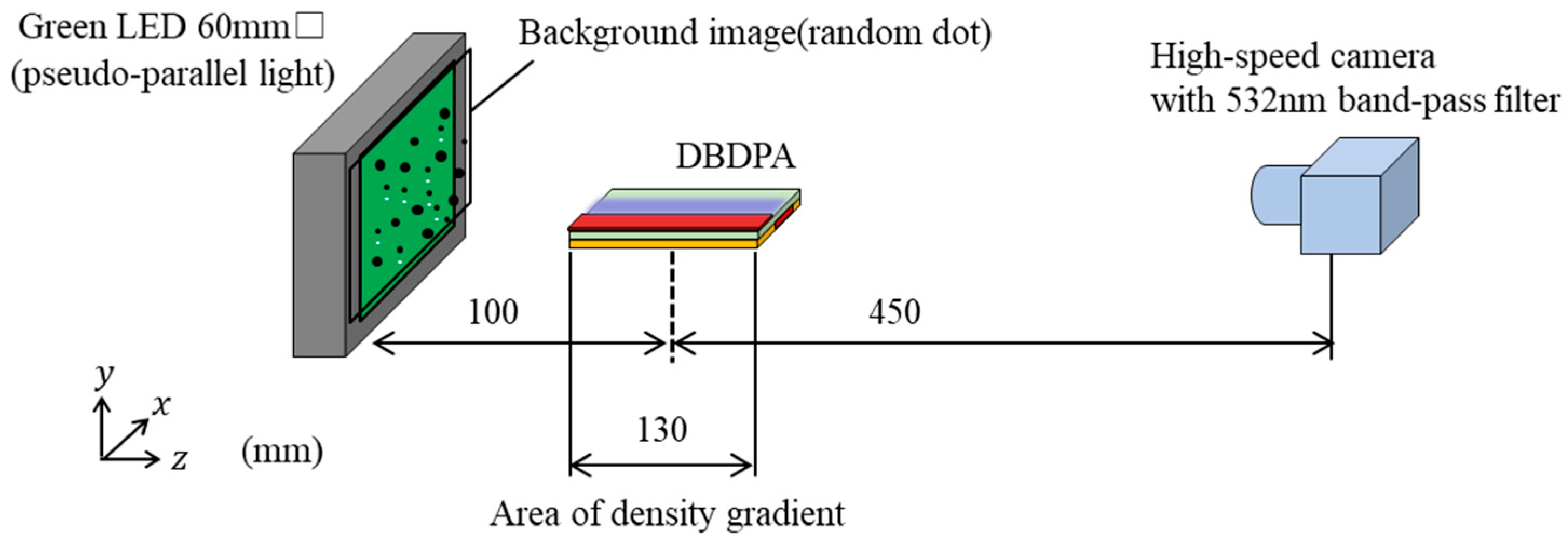



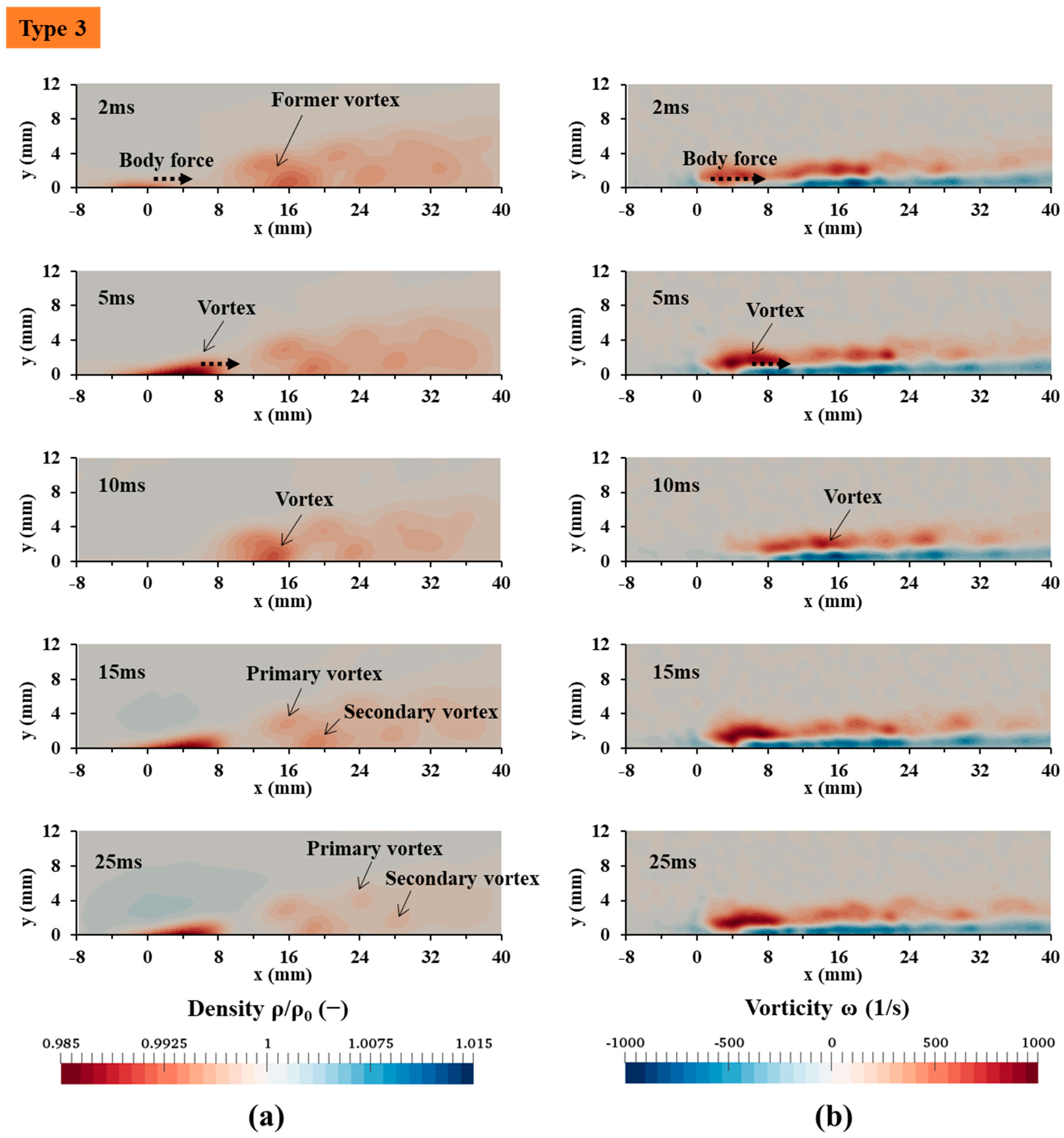


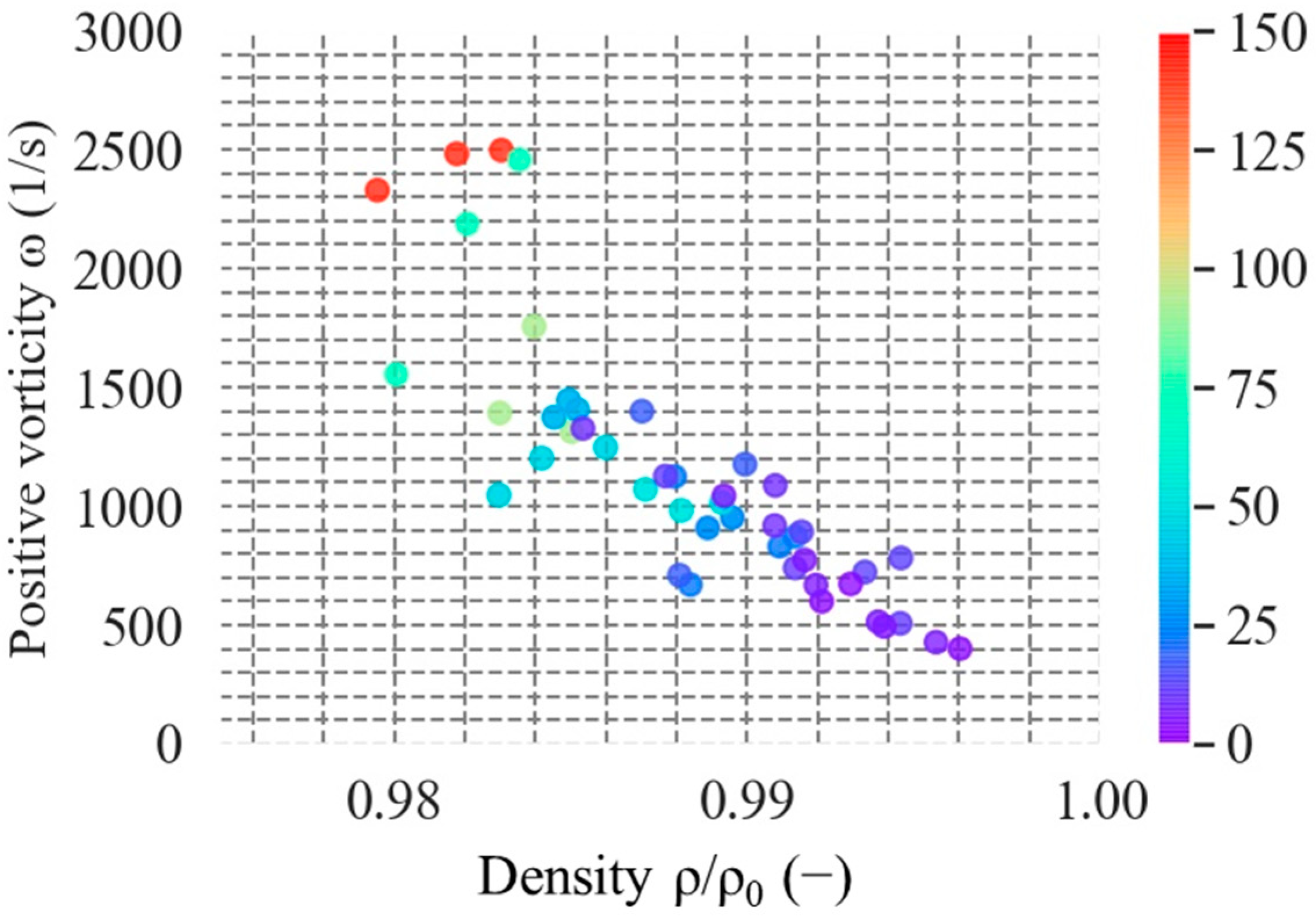
| Image-Correlation Algorithm | Window Deformation Iterative Multigrid |
|---|---|
| Interrogation window size | 1st: 96 pixels 2nd: 16 pixels |
| Overlapping Area | 25% |
| Field of view | 40 mm × 12 mm |
| Image-Correlation Algorithm | Window Deformation Iterative Multigrid |
|---|---|
| Interrogation window size | 1st: 48 pixels 2nd: 32 pixels |
| Overlapping Area | 25% |
| Field of view | 40 mm × 12 mm |
| F (kHz); 3.6, 7.2, 14.4 | Ton (ms) | |||||
|---|---|---|---|---|---|---|
| 0.5 | 1.0 | 2.0 | 4.0 | 8.0 | ||
| BR (%) | 20 | 400 | 200 | 100 | 50 | 25 |
| 40 | 800 | 400 | 200 | 100 | 50 | |
| 80 | 1600 | 800 | 400 | 200 | 100 | |
| F = 3.6 (kHz) | Ton (ms) | |||||
| 0.5 | 1 | 2 | 4 | 8 | ||
| BR (%) | 20 | 400 | 200 | 100 | 50 | 25 |
| 40 | 800 | 400 | 200 | 100 | 50 | |
| 80 | 1600 | 800 | 400 | 200 | 100 | |
| (a) | ||||||
| F = 7.2 (kHz) | Ton (ms) | |||||
| 0.5 | 1 | 2 | 4 | 8 | ||
| BR (%) | 20 | 400 | 200 | 100 | 50 | 25 |
| 40 | 800 | 400 | 200 | 100 | 50 | |
| 80 | 1600 | 800 | 400 | 200 | 100 | |
| (b) | ||||||
| F = 14.4 (kHz) | Ton (ms) | |||||
| 0.5 | 1 | 2 | 4 | 8 | ||
| BR (%) | 20 | 400 | 200 | 100 | 50 | 25 |
| 40 | 800 | 400 | 200 | 100 | 50 | |
| 80 | 1600 | 800 | 400 | 200 | 100 | |
| (c) | ||||||
Publisher’s Note: MDPI stays neutral with regard to jurisdictional claims in published maps and institutional affiliations. |
© 2022 by the authors. Licensee MDPI, Basel, Switzerland. This article is an open access article distributed under the terms and conditions of the Creative Commons Attribution (CC BY) license (https://creativecommons.org/licenses/by/4.0/).
Share and Cite
Emori, K.; Kaneko, Y.; Nishida, H. Comparison between Density and Velocity Fields in Burst Modulation of a Dielectric-Barrier-Discharge Plasma Actuator. Actuators 2022, 11, 340. https://doi.org/10.3390/act11110340
Emori K, Kaneko Y, Nishida H. Comparison between Density and Velocity Fields in Burst Modulation of a Dielectric-Barrier-Discharge Plasma Actuator. Actuators. 2022; 11(11):340. https://doi.org/10.3390/act11110340
Chicago/Turabian StyleEmori, Kenta, Yutaka Kaneko, and Hiroyuki Nishida. 2022. "Comparison between Density and Velocity Fields in Burst Modulation of a Dielectric-Barrier-Discharge Plasma Actuator" Actuators 11, no. 11: 340. https://doi.org/10.3390/act11110340





